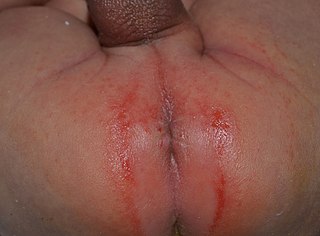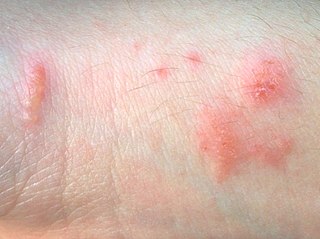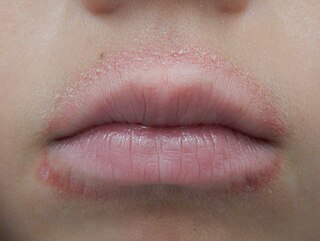| Abietic acid dermatitis | |
|---|---|
 | |
| Various types of rosin for violins, violas and cellos | |
| Specialty | Dermatology |
Abietic acid dermatitis is a contact dermatitis often seen in association with musical instruments. [1]
| Abietic acid dermatitis | |
|---|---|
 | |
| Various types of rosin for violins, violas and cellos | |
| Specialty | Dermatology |
Abietic acid dermatitis is a contact dermatitis often seen in association with musical instruments. [1]
The main cause is a type-I hypersensitivity reaction to products containing abietic acid, such as the rosin/colophony, which is commonly used as a friction-increasing agent. Players of bowed string instruments (violin, viola, cello, double bass) rub cakes or blocks of rosin on their bow so it can grip the strings. Ballet and flamenco dancers sometimes rub their shoes in powdered rosin to reduce slippage before going on stage. Gymnasts, baseball pitchers and ten pin bowlers use rosin to improve grip. Common locations of this contact dermatitis are hands, face and neck. [2] : 1374
It has also occurred as a result of dehydroabietic acid in an over-the-counter hydrocolloid dressing. [3]

Cutaneous disorders in musicians include frictional injury ("fiddler's neck"), hyperhidrosis, acne mechanica and vascular compromise. Other agents of irritant and allergic contact dermatitis may be rosewood, Makassar ebony, cocobolo wood, African blackwood, nickel, reed, propolis (bee glue), chromium and paraphenylenediamine. Patch testing can be performed for identification of the cause.
Treatment may include corticoids, astringents, and keratolytics. Dermatoses tend to be recurrent unless the use or contact can be avoided. Discontinuation of the instrument is curative in almost all cases, but usually impractical.

Rosin, also called colophony or Greek pitch, is a solid form of resin obtained from pines and some other plants, mostly conifers, produced by heating fresh liquid resin to vaporize the volatile liquid terpene components. It is semi-transparent and varies in color from yellow to black. At room temperature rosin is brittle, but it melts at stove-top temperature. It chiefly consists of various resin acids, especially abietic acid. The term "colophony" comes from colophonia resina, Latin for "resin from Colophon", an ancient Ionic city.

Abietic acid is an organic compound that occurs widely in trees. It is the primary component of resin acid, is the primary irritant in pine wood and resin, isolated from rosin and is the most abundant of several closely related organic acids that constitute most of rosin, the solid portion of the oleoresin of coniferous trees. Its ester or salt is called an abietate.

Irritant diaper dermatitis is a generic term applied to skin rashes in the diaper area that are caused by various skin disorders and/or irritants.

Contact dermatitis is a type of inflammation of the skin. Some symptoms of contact dermatitis can include itchy or dry skin, a red rash, bumps, blisters, and swelling. The rash is not contagious or life-threatening, but it can be very uncomfortable.

Urushiol-induced contact dermatitis is a type of allergic contact dermatitis caused by the oil urushiol found in various plants, most notably species of the genus Toxicodendron: poison ivy, poison oak, poison sumac, and the Chinese lacquer tree. The name is derived from the Japanese word for the sap of the Chinese lacquer tree, urushi. Other plants in the sumac family also contain urushiol, as do unrelated plants such as Ginkgo biloba.

Allergic contact dermatitis (ACD) is a form of contact dermatitis that is the manifestation of an allergic response caused by contact with a substance; the other type being irritant contact dermatitis (ICD).
Irritant contact dermatitis is a form of contact dermatitis that can be divided into forms caused by chemical irritants and those caused by physical irritants.

Cheilitis is a medical condition characterized by inflammation of the lips. According to its onset and course, cheilitis can be either acute or chronic. Most cheilitis is caused by acute sun exposure. Allergic tests may identify allergens that cause cheilitis.
Keratolysis exfoliativa is a sometimes harmless, sometimes painful skin condition that can affect the focal surface of the fingers and/or the palm or soles of the feet. It is often misdiagnosed as chronic contact dermatitis or psoriasis. It is characterized by dry skin and superficial, air-filled blisters. These blisters can be peeled off very easily and will leave reddish, tender areas. The loss of this corneal layer of the skin, which protects the underlying layers, leaves the skin more vulnerable to dryness and cracking.
Id reactions are types of acute dermatitis developing after days or weeks at skin locations distant from the initial inflammatory or infectious site. They can be localised or generalised. This is also known as an 'autoeczematous response' and there must be an identifiable initial inflammatory or infectious skin problem which leads to the generalised eczema. Often intensely itchy, the red papules and pustules can also be associated with blisters and scales and are always remote from the primary lesion. It is most commonly a blistering rash with itchy vesicles on the sides of fingers and feet as a reaction to fungal infection on the feet, athlete's foot. Stasis dermatitis, allergic contact dermatitis, acute irritant contact eczema and infective dermatitis have been documented as possible triggers, but the exact cause and mechanism is not fully understood. Several other types of id reactions exist including erythema nodosum, erythema multiforme, Sweet's syndrome and urticaria.

Pustulosis palmaris et plantaris is a chronic recurrent pustular dermatosis localized on the palms and soles only, characterized histologically by intraepidermal pustules filled with neutrophils. It can occur as part of the SAPHO syndrome.
African blackwood dermatitis is a condition characterized by an allergic contact dermatitis associated with a musical instrument made of a particular type of wood.

Paederus dermatitis, medically known as dermatitis linearis, is a skin irritation resulting from contact with the hemolymph of certain rove beetles, a group that belongs to the insect order Coleoptera and the genus Paederus. Other local names given to Paederus dermatitis include spider-lick, whiplash dermatitis, and Nairobi fly dermatitis.
Tulip fingers are a cutaneous condition, a combined allergic and irritant contact dermatitis caused by contact with tulip bulbs.
An alginate dressing is a natural wound dressing derived from carbohydrate sources released by clinical bacterial species, in the same manner as biofilm formation. These types of dressings are best used on wounds that have a large amount of exudate. They may be used on full-thickness burns, surgical wounds, split-thickness graft donor sites, Mohs surgery defects, refractory decubiti, and chronic ulcers. They can also be applied onto dry wounds after normal saline is first applied to the site of application.
Symmetrical drug-related intertriginous and flexural exanthema (SDRIFE), more popularly known as baboon syndrome because of its resemblance to the distinctive red buttocks displayed by female baboons, is a systemic contact dermatitis characterized by well-demarcated patches of erythema distributed symmetrically on the buttocks. The cause of the syndrome may be drug-related, i.e. induced by systemic administration of hydroxyzine penicillin, iodinated radio contrast media and others.
Acute cutaneous lupus erythematosus is a cutaneous condition characterized by a bilateral malar rash and lesions that tend to be transient, and that follow sun exposure. The acute form is distinct from chronic and subacute cutaneous lupus erythematosus, which may have different types of skin lesions. Cutaneous lupus erythematosus is associated with both lupus erythematosus-specific lesions and cutaneous manifestations that are not specific to lupus erythematosus, such as oral ulcers and urticaria. Because of the diagnostic criteria used to diagnose systemic lupus erythematosus, a patient with only cutaneous manifestations may be diagnosed with the systemic form of the disease.
Fiddler's neck is an occupational disease that affects violin and viola players.

Lip licker's dermatitis is a type of skin inflammation around the lips due to damage by saliva from repetitive lip licking and is classified as a subtype of irritant contact cheilitis. The resulting scaling, redness, chapping, and crusting makes a well-defined ring around the lips. The rash may extend as far as the tongue can reach and usually does not occur at the corners of the mouth. It commonly occurs during winter months but some people can have it year-round if lip licking is a chronic habit.
The intense contact between a musical instrument and skin may exaggerate existing skin conditions or cause new skin conditions. Skin conditions like hyperhidrosis, lichen planus, psoriasis, eczema, and urticaria may be caused in instrumental musicians due to occupational exposure and stress. Allergic contact dermatitis and irritant contact dermatitis are the most common skin conditions seen in string musicians.